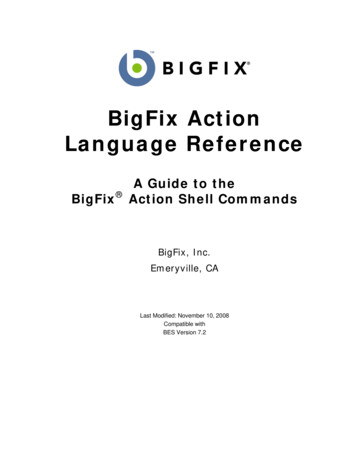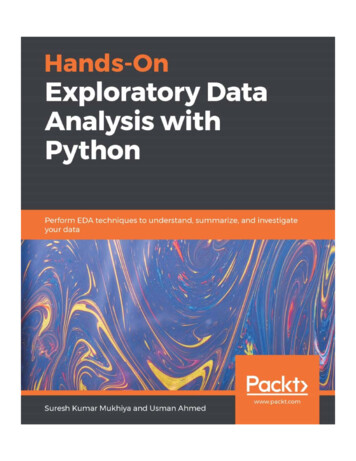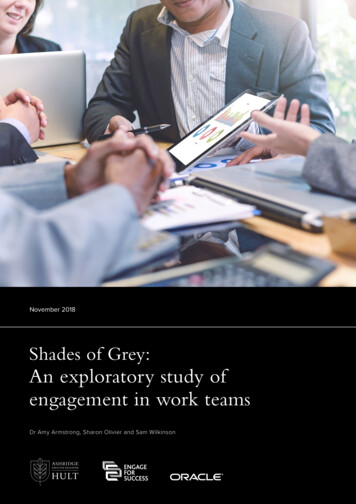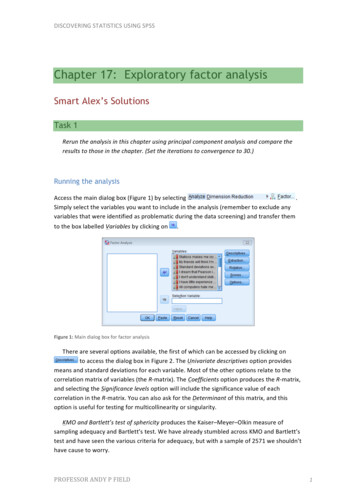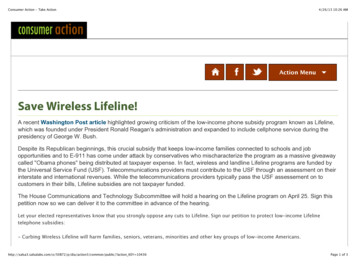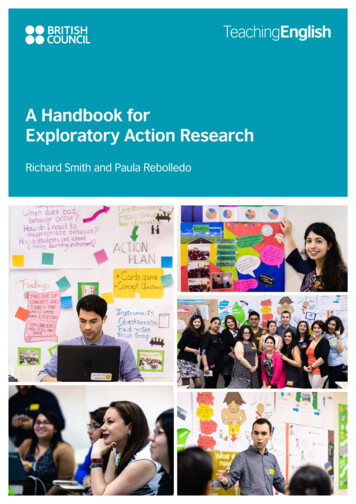
Transcription
A Handbook forExploratory Action ResearchRichard Smith and Paula Rebolledo
ContentsIntroduction 31.Foundations 81.1 – Successful teaching 91.2 – A challenging teaching situation 91.3 – The need for information 101.4 – What’s the value of research? 122.What is teacher-research? 142.1 – Demystifying research 152.2 – But what is research? 162.3 – What does teacher-research look like? Lorena’s story 173.What is Exploratory Action Research? 193.1 – The value of ‘exploring’ 203.2 – Exploratory research: Andrea’s story part 1 213.3 – Action research: Andrea’s story part 2 233.4 – So, what is Exploratory Action Research? 254.What shall I explore – and what are my questions? 284.1 – Motivations for doing research 294.2 – Your own motivations – and narrowing down your focus 314.3 – From topic to exploratory questions 324.4 – Teresa’s exploratory questions 344.5 – Your own questions 354.6 – SMART questions 375.How can I explore? 405.1 – Different sources of information 415.2 – Mauro’s story 485.3 – Combining information from different sources 495.4 – What should I keep in mind before collecting data? 516.What do I find? 556.1 – Daniela’s story 566.2 – Analysing and interpreting qualitative data 586.3 – Interpreting quantitative data 61Contents 1
Contents continued7.What shall I change? 667.1 – Is ‘new action’ needed? 677.2 – Javier’s story 687.3 – Planning a change 697.4 – Implementing the change as planned 728.What happens? 748.1 – Lorena’s story – revisited 758.2 – A reminder of research methods 768.3 – Comparing exploratory and action research findings 778.4 – Interpreting self-critically 798.5 – Reflecting on your own development – the major finding? 809.Where do I go from here? 829.1 – Sharing your research with others 839.2 – Sharing your research by writing 859.3 – Consider participants’ rights 869.4 – Joining wider communities 879.5 – Continuing your research 889.6 – Your personal journey with this handbook 9010. Extra material 932 Contents
IntroductionThis is a practical handbook, written in a non-academic, teacher-friendlystyle, to show teachers how they can engage in practitioner research forcontinuing professional development and for the benefit of their students.The book is unique in the literature on teacher-research in ELT in beingparticularly targeted at secondary and primary school teachers workingin relatively difficult circumstances.
Difficult circumstances andExploratory Action ResearchTeacher-research has long been considered a desirable formof professional development, and we will go over some ofthe arguments for this in Chapters One and Two of this book.However, one thing teachers often wonder is: ‘How can I asa teacher find time to do research when I don’t even havetime to cope with all the normal demands in my classroom?’.The kind of practitioner research we are presenting in thisbook – Exploratory Action Research – has been developedwith and for secondary school teachers in classes of up to40 students, where teachers are teaching up to 40 lessonsa week. The original context for this was a project withteachers in Chilean secondary schools (the ‘ChampionTeachers’ project – more below). We have strongly in mindthe difficulties faced by teachers in such circumstances.In fact, based on teachers’ actual experiences in the projectswe’ve been involved with (in Peru, India and Nepal as well asChile), a major point we want to make is this: ExploratoryAction Research can in itself be an effective way to addressand cope with difficult circumstances (heavy teaching loads,large classes, a lack of material resources, and so on) sinceit enables teachers to gain a better understanding of theirclassroom contexts and so develop more appropriate waysof teaching, without waiting for solutions from outside.We stress in this book, then, that a particular way of doingteacher-research – Exploratory Action Research – isdesirable as well as feasible in relatively difficultcircumstances.Teachers often report feeling rather like an octopus in suchsituations, needing to deal with the many things that aregoing on at the same time, under continual stress and withcontinual pressures to act quickly to solve problems. Whensomething is not working, a quite normal response is to tryout different solutions until you find one that works. Butwhen problems are multiplied there comes a point where itjust isn’t possible to address all the problems you’re facing.What to do in such circumstances? Our main suggestion isto step back from the situation and take a good careful lookat the nature of the problem rather than jumping in with apossible solution that hasn’t been thought about enoughand may, then, be inappropriate.1So, what we recommend here is not adding to your existingburden with extra actions but instead taking a step back,creating a space for reflection and exploration in order tounderstand a situation better before taking action.In short, in this book we provide an introduction to actionresearch while emphasising that before the ‘action’ that‘action research’ implies, there is a need for a carefulexploratory phase. Accordingly, a large part of the booktakes you step by step through the careful explorationof a situation, only later coming to the ‘action’ phase whichis normally associated with action research.The Chilean Champion Teachers project– and other contexts‘Exploratory Action Research’, the approach presented inthis book, was originally developed in the context of a jointBritish Council–Ministry of Education project in Chile whichis currently in its fifth year.1This programme is innovative in being directed speciallyat secondary school teachers in a public education system.The ideas developed in the context of this programme havealso already shown their worth in India and Nepal (in thecontext of projects run by the All India Network of EnglishTeachers (AINET), the British Council Aptis Action ResearchAward Schemes (AARMS) in both India and Nepal, andGauhati University, Assam. They have also been incorporatedinto a TESOL CALL Interest Section Electronic Village Online(2017 and 2018) and are being spread via a ChampionTeachers programme organised by the British Council inPeru (2017–18).The Ministry of Education in Chile is planning to distributethis book to secondary teachers in Chile, recommending itsuse within teacher ‘networks’ (teacher self-help groups). Thebook will also be promoted (by the Ministry of Education andthe British Council in Chile) for use in pre-service teachereducation programmes, and will also serve as a suitableintroduction to more academic research approaches.While particularly situated in and appropriate to Chileanexperience, and using concrete examples from theChampion Teachers project, we hope the book will appealalso to a worldwide readership of teachers and teachereducators in comparable circumstances.For more information on the Champion Teachers programme and the development of the Exploratory Action Research approach, see‘Teacher-research as CPD: A project with Chilean secondary school teachers’ by Richard Smith, Tom Connelly and Paula Rebolledo (2014),in Innovations in the Continuing Professional Development of English Language Teachers (edited by David Hayes for the British Council); also,‘Exploratory action research: why, what, and where from?’ by Richard Smith (2015), in Teacher-researchers in Action (edited by Kenan Dikilitas,Richard Smith and Wayne Trotman for IATEFL Research SIG).4 Introduction
Style of presentationThe book is targeted in particular at secondary and primaryteachers (for whom few such books have been previouslyproduced) and is written in a jargon-free, non-academicstyle, with many concrete examples.We have deliberately tried to make this book different fromprevious treatments of teacher-research in the field of ELT,aiming for as non-academic an approach as possible toreflect the idea that teacher-research is by teachers andfor teachers and their students, not needing to adhere torelatively dry or ‘academic’ norms of presentation or tostandards of rigour which are imposed from outside.As far as possible, then, rather than prescribing particularactivities in the abstract or moving from theory to practice,we proceed from example to recommendation. Theexamples are real, not invented ones, and they come fromteachers in relatively difficult circumstances, not in wellresourced or otherwise privileged contexts. Thus, we referthroughout to cases from the Champion Teachers project,in particular those represented in the companion ChampionTeachers: Stories of Exploratory Action Research book,1which readers are encouraged to read to gain furtherunderstanding. Instructions and examples are accompaniedby practical tasks, with answers to most of these beingprovided in an Answer Key at the back of the book.We wanted the book to be visually appealing (well-designed,and including illustrations and photographs) in order toenhance its accessibility, given that the idea of carrying out‘research’ can be off-putting to teachers, who may feel thatit is not ‘for’ them.Although the book does not constitute a full introduction to‘Research Methods’, our own experience with pre-service aswell as in-service teachers has shown us that engaging inExploratory Action Research represents a good, practicalfirst step towards more academic research methods trainingand research engagement. This, of course, is not the majoraim of the book, which is to introduce teachers to thepersonal and professional benefits of researching their ownclassrooms, and to show how this can be feasible as well asuseful, even for teachers in very difficult circumstances.AcknowledgmentsWe gratefully acknowledge the support of the followingpeople, at different times, in making this Handbook a reality:Katherine Hutter, Deborah Sepulveda and Isabel González(British Council Chile); Andrew Chadwick and Tom Connelly(both, formerly British Council Chile); John Knagg (BritishCouncil, UK); personnel of the English Opens Doorsprogramme, Ministry of Education, Chile; mentors andmentees in the Chilean Champion Teachers programme pastand present, including Claudia Bustos, Lorena Muñoz, LeylaNuñez, Daniela Gajardo, Camila Villalobos, Javier Avalos,Mauro Saéz, Teresa Ríos, Esteban López and Andrea Robles.We also thank Teresa Perčić, Carolina Cid, GemmaMaldonado and Jeannie Fernández for allowing us to usetheir stories / materials. Finally, a special word of thanks toJason Anderson for his work as content editor for the bookand, beyond that, for his concrete, creative suggestions forcontent in several places.How to use this bookThe book has been written to be used by teachers workingon their own; in self-sustaining groups of teachers or menteegroups; within teacher associations supporting teacherresearch; or in pre-service or in-service teacher educationprogrammes. The only assumption is that readers have somecurrent classroom contact with students, since tasks willrequire reflection on current teaching experience.Ideally, you will find someone else to interact with about thecontents and to answer tasks together with. If not, try toengage with the book actively and carry out tasks in yourmind, checking answers in the back of the book wheneveryou see the ‘@’ symbol.1Edited by Paula Rebolledo, Richard Smith and Deborah Bullock (2016). London: British Council. Online: http://bit.ly/champion-teachersIntroduction 5
Start here!You may like to try out this self-diagnosis exercise before we begin. It gives an overviewof the different kinds of skill and ability (‘competency’) we hope you will have developedby the end of the book. The exercise is repeated again at the end of the book to help yousee what you’ve learned.ExplanationThe main purpose of the form on the next page is to helpyou identify existing strengths, and identify areas where youwould particularly value professional development andsupport. The diagnostic tool is based around fifteen‘Exploratory Action Research Competencies’.Each competency has five levels and you need to decidefor each competency which level you are currently workingat. It is expected that you will have a range of competenciesat different levels, but at the start you may not have many(or any) above Level 0.Exploratory Action Research CompetenciesLevel 0I do not currently have this competency.A. I can reflect on and analyse my practiceLevel 1I am beginning to apply this competency.Level 2I am applying this competency but haveareas which require improvement.Level 3I am applying this competency withconfidence.Level 4I am applying this competency withstrength.B. I know how to improve my teachingC. I can identify what is good about my teachingD. I can see what problems are occurring in myclassroomE. I can identify a focus for research into myclassroomF. I can consider how to turn successes, problemsand other issues into research questionsG. I can identify appropriate sources of evidence forresearch questionsH. I can decide how to gather information to answermy questionsI. I can collect evidence to answer researchquestionsJ. I can analyse evidence collectedK. I can incorporate my students’ suggestions and/oropinions into my teachingL. I can design an action plan based on explorationof my teachingM. I can put an action plan into practice based onexploration of my teachingN. I can evaluate the results of an action planO. I know how to communicate/present researchfindings orally and in writing6 Introduction
Exploratory Action Research DiagnosisNow please fill out the table below circling a number from 0 to 4 corresponding to the level you are currently workingat for each competency.CompetenciesLevelA. I can reflect on and analyse my teaching01234B. I know how to improve my teaching01234C. I can identify what is good about my teaching01234D. I can see what problems are occurring in my classroom01234E. I can identify a focus for research into my classroom01234F. I can consider how to turn successes, problems and other issues into research questions01234G. I can identify appropriate sources of evidence for research questions01234H. I can decide how to gather information to answer my questions01234I. I can collect evidence to answer research questions01234J. I can analyse evidence collected01234K. I can incorporate my students’ suggestions and/or opinions into my teaching01234L. I can design an action plan based on exploration of my teaching01234M. I can put an action plan into practice based on exploration of my teaching01234N. I can evaluate the results of an action plan01234O. I know how to communicate/present research findings orally and in writing01234These are the skills and areas of knowledge you’ll be developing as you go through this book. So, let’s begin!Introduction 7
1. FoundationsYou, your learners, your experience and your capabilities, are the majorfoundations of this book. Understanding your practice, learning from yourown teaching, listening to your learners and developing more confidencein your experience and capabilities will be, we hope, the main outcomesof our work together.In your everyday teaching you engage in many activities; such as planning,instructing, arranging activities, assessing, giving feedback, etc. Thoseexperiences – both successful and more challenging ones – are the startingpoint of your work through this book. So let’s begin by looking at some of them!
1.1 Successful teachingCommentaryPaula will share with you a successful experience from herown classroom teaching as an example for the first task.By asking you to reflect about a successful situation, we areinviting you to recall and describe the different aspects thatmade this experience a positive one. This exercise can bevaluable since you can later use some of these memoriesto try to re-live this successful event or build new positiveevents from it.“Some years ago I was teaching a large group ofteenagers in a secondary school. I had to teach themcountries and nationalities, which seemed a rather simpletask, but it proved to be challenging for them. They notonly struggled to remember the words for differentcountries and nationalities but also had problemsremembering their pronunciation. I also had the difficultyof having only a few hours left before the end of thesemester with one particular group so I had to come upwith a solution fast. Then, I thought of creating a dominogame consisting of countries on one side and nationalitieson the other. Every time learners wanted to match a flagto a nationality, they had to say something like ‘She is fromSpain. She is Spanish’, therefore it required a lot ofrepetition. After doing this game, I moved to a morecommunicative task, which they could perform moreeffectively. I was very pleased with the result. Not only didthe students remember the vocabulary of the lesson andwere able to move from a controlled practice type of taskto a freer communicative task, they were also engaged.I saw them taking notes and this showed me they wereworking hard, I heard them encouraging each other topronounce the words correctly. I felt the activity reallysuited its purpose. I think that, for me, successful teachingis when students are engaged, participating actively, andwhen they make progress in their learning.”Task 1.1Think about a recent successful experience / activity inyour classroom. Go over it in your mind’s eye. Tell someoneabout it if possible.How do you know it was successful? What did you see,hear and feel that told you it was successful?I sawI heardI feltWhat does this tell you about the meaning of ‘successfulteaching’ for you?For me, successful teaching is when9 FoundationsKeep in mind, that ‘success’ in teaching doesn’t just meanhelping students perform better in tests. Success can alsobe defined in a number of ways which go beyondassessment and which can also be valid. If you ‘see’ studentsfully engaged and you ‘hear’ their opinions as they activelyparticipate in the lesson; then these signs of success aresomething you may like to remember and look for in futurelessons. These are the kind of signs that we hope you will beseeing again as an outcome of Exploratory Action Research– after all, its main purpose is to help you and your studentsachieve greater success in the classroom.1.2 A challenging teaching situationWe have shared with you an example of a successfulexperience and asked you to share your own. We willnow turn to less positive experiences, which can alsobe effective to trigger reflection about your practice.We will share with you a challenging teaching and learningsituation from Camila Villalobos, a Chilean teacher, as anexample for the second task. Camila teaches at a schoolin Chiloé Island in the south of Chile and she teaches pupilsaged 10 to 13.“There are 28 students in each level approximately andin each grade I have a group of five or six students thatcome from P.I.E. (Programme for Inclusion in Education)and in each of my lessons these students did notparticipate and they were not motivated in comparisonwith the rest of the class. For me as a teacher, all mystudents are important and I needed to help them all todevelop the same competences in English. The majorityof P.I.E. students come from the countryside and otherislands near to Chiloe Island; many of them never hadEnglish as a subject and those who had English did notachieve the competences of their corresponding grade.Most of these students live with foster families as wellas in the town boarding school during the week and travelto their houses on the weekends to see their families. I hadtried different strategies such as to let them sit with theirfriends to feel more comfortable, I changed my toneof voice and my body language with them and evenencouraged them to ask questions in class bypersonalising the lessons more, but nothing seemedto work.”
Task 1.2Think about a recent challenging or unsatisfactoryexperience in your classroom. Go over it in yourmind’s eye. Tell someone about it if you’re not alone.Then ask yourself (or have someone ask you):What made it challenging or unsatisfactory? Which aspectsof it proved problematic? What did you see, hear and feelthat told you it was so?I sawI heardSeeing, hearing and feeling give us what we have calledsigns which tell us whether a particular situation issuccessful or unsatisfactory.‘Sign’: n. ‘Something regarded as an indicationof what is happening or going to happen’1Signs of success can include seeing your students smilingwhile doing a task, or hearing them speak to each otherabout a task or feeling the task is going well from your ownexperience. This is useful and valid information. However,signs sometimes only provide a partial view of situations.They can: ignore the perception of students give information only about one aspect of the situation I feltCommentaryTeachers experience many challenging situations whenthings don’t work out as we would like them to, but, as withsuccessful situations, we don’t usually have the time to sitand think about what happened and why. A first step todoing this can be to think about what tells you things arenot going according to plan – in other words, the signs oflack of success.You have now reflected on one successful teachingsituations from Paula’s experience, one challengingsituation from Camila’s experience and two from your own.We have used these situations to show how, by looking at asituation closely, you can identify signs of success or lackof it so that you come closer to understanding the situation.In the next chapter we’ll start to see where you can go fromhere – either expanding on success (as with case 1.1) ortrying to solve a problem (as with case 1.2). For now, though,let’s think a bit more about the signs that come throughyour senses about whether something is or isn’t workingand how you can collect information to understand differentsituations better.1.3 The need for informationIn the examples you read above, Paula and Camila ‘saw’,‘heard’ and ‘felt’ certain things that ‘told’ them somethingwas working or wasn’t. In the task, we also asked you tofocus on what you saw, heard and felt since it is our senseswhich tell us (teachers) what is happening in our classrooms.When we ‘feel’ something, we are also using our intuition,which is nurtured by years of teaching experience.mask other aspects of a situation that cannot be easily‘seen’ or heard’make us overlook information which can be useful to getnew understandings of a situation.Some teachers we have been working with told us how theirinitial thoughts about a situation changed when they lookedat it more closely, from other perspectives – in other words,when they opened their eyes and ears more and/or‘borrowed’ others’ eyes and ears. Here are a couple ofexamples;“This exploratory research helped me be more awareof what I am doing in the classroom; unfortunately, I hadbeen looking for what my students were doing wronginstead of what I was doing wrong. In other words, weneed to have a look at the whole process before judgingthe students’ performance.” (Leyla Nuñez)“From this exploration, the first finding was verysurprising for me. Before the research I thought theydidn’t want me to speak in class. But in their answers tomy questionnaire a little more than a half of them saidthey wanted a class in English. It was a total changeof my point of view.” (Daniel Santana)“As a teacher, when we have doubts about our ownmethods in the lesson, we need to focus on our students’interests before focusing on the content. We usually thinkthat the content is the problem, but it may not be that.”(Camila Villalobos)These teachers realised that by taking a more careful lookat a particular situation, their views changed. In otherwords, the signs they previously had of what was workingor not working were incomplete or simply inappropriate toexplain a situation. This is why the collection of additionalinformation is important and is needed for understandinga situation better, in greater detail and from differentperspectives. The information collected can be useful tomake interpretation
of teaching, without waiting for solutions from outside. We stress in this book, then, that a particular way of doing teacher-research – Exploratory Action Research – is desirable as well as feasible in relatively difficult c



